

 |
 |
Josep-Maria Batalla-Busquets and Carmen Pacheco-Bernal
Universitat Oberta de Catalunya, Spain
The use of e-learning for on-the-job training has grown exponentially in the last decade due to it being accepted by people in charge of businesses. Few papers have explored virtual training from the workers’ standpoint, that is, the perception they have about the different training methodologies (face-to-face vs. virtual) and the attitudes they have towards on-the-job learning. Training, in this context, is an investment for both the two participating agents: businesses and workers. It seems logical that knowing the perceptions and attitudes shown by the targets of the training is, at least, as important as knowing the advantages for the companies.
To analyse workers’ perceptions and attitudes we conducted an online survey of 2,000 employees of the leading European savings bank, CaixaBank (http://www.caixabank.com/index_en.html), on training habits, perceptions, motivations, and disincentives of undertaking face-to-face or online instruction.
The results reveal that workers perceive e-learning as a more flexible and up-to-date training methodology. On the other hand, face-to-face training continues to be perceived as a more motivating methodology compared to virtuality and with better explanations from the course trainers. As regards motivations given by the workers when it comes to training, there are three main groups of attitudes: those which are more affective and social, those which reveal poor adaptability or fear of the new training requirements, and, finally, those linked to the knowledge society.
Such results state that while the benefits of distance methodology can be clearly identified from the company’s point of view (i.e., as a flexible and efficient methodology to develop the employees’ skills and knowledge), from the employees’ standpoint, the advantages of virtual training are not so clear and depend to a great extent on their attitude towards the use of virtuality.
Keywords: E-learning; on-the-job training; worker’s attitudes nd perceptions; ICT; perceptual map; factor analysis
Training of workers has become, since the final third of the 20th century, one of the key factors of company competitiveness within an economy that Castells (2003) describes as informational and global. Massive incorporation by business of information and communication technologies (ICT) has changed production processes as well as business activity itself (Valdaliso & López, 2000). Simultaneously, and in a reciprocal way, it has speeded up economic globalization processes. This broader penetration of ICT has entailed an increase in the use of knowledge as both a business input and output. This has, at the same time, led to a profound change in the conditions and characteristics of the labour market (Vilaseca & Torrent, 2003).
Changes to the workforce in OECD countries are causing changes to companies: more flexibility for companies when creating job titles, more frequent developments in labour activity, modifications of worker responsibilities within the company and even within the economic sector as a whole. Companies and workers face an increasing need to recycle knowledge and skills (Carnoy, 2001). A consequence of this process of business digitalization is the increase by companies in the demand for new job skills. Thus, for jobs that require higher levels of training, more worker autonomy and new management skills are favoured (Bresnahan et al., 2002). This new demand, dubbed self-programming work by Castells (2003), requires workers with autonomy, initiative, and the capability to make decisions, as well as the ability to reprogram their skills and knowledge according to the different tasks that they are entrusted with in the ever-changing business environment.
Massive incorporation of knowledge into business activity and increasing labour market malleability has, in recent decades, led to a generalized increase in the need for continuous vocational training (Castells, 2003). The entirety of training activities developed by companies, workers, or their representing organizations must be directed to improving the professional competencies and skills of active workers, so that they may face the needs of a changing and digitalized global reality.
The importance of learning is primarily because of the need for organisations to respond to rapid and continuous change in the organisation’s external environment (Coetzer & Perry, 2008). Also, the need for ongoing employee training requires a learning environment that makes it possible to progress professionally and, at the same time, to acquire general and firm-specific skills and new competencies (Fan & Wei, 2010). The training environment that favours direct linking with real labour experience is training in the workplace.
In the report Learning for Jobs, edited by the OECD (2010), the four main advantages of workplace learning are, firstly, a high-quality learning atmosphere that allows students to acquire practical and updated skills with trainers who are familiar with working methodology and the use of new technologies. Secondly, workplace learning makes bidirectional flow of information between potential employers and employees easier, which makes possible later recruitment much more efficient and less costly. Thirdly, the fact that companies train their workers is a sign that a vocational training programme is valuable in the labour market. Finally, workers trained on the job can make a productive contribution to the company.
The consequences of traditional management, production, and working methods in a knowledge-based economy are that they have a direct impact on people’s lives by making labour relationships more flexible, either voluntarily or by imposition, thus requiring openness to innovation as an essential value in the company as well as a continuous vocational recycling process. Such constant processing of knowledge, updating of skills, and continuous relearning favours the use of e-learning as an essential methodology that guarantees the perfect symbiosis between work and training (Batalla et al., 2010).
Within the framework of e-learning for on-the-job employee training, this research aims at studying what the workers’ perception of e-learning is as well as the motivations that make them pursue training with this methodology. The main purpose of this paper is to answer these two questions related to on-the-job e-learning, questions which have been tackled by very few studies.
To this end, the next section is a brief review of literature on use of in-company e-learning, stressing the workers’ perceptions and motivations. Subsequently, we will explain the methodology and finally we will discuss the main results and the conclusions reached.
Before outlining the theoretical framework of this paper, it is appropriate to explain what we understand as e-learning. E-learning has been defined by many authors in recent decades (Wilson, 1996; Piccoli, et al., 2001; Rosenberg, 2001; Nisar, 2002; Ruipérez, 2003; Taylor & Osorio, 2005; Bates, 2008; Sangrà, et al., 2012). In our paper, following research by Piccoli, et al. (2001), Ruipérez (2003), Taylor and Osorio (2005), and Sangrà, et al. (2012), we define e-learning as the distance training methodology based on the use of information and communication technologies that allows interaction and asynchronous communication amongst participants as well as the access to a broad set of teaching resources. Thus, the student becomes the centre of the training process, managing his/her own learning with the help of external tutors.
The use of on-the-job e-learning, in constant growth in recent decades, is a relatively new form of providing training to workers (Lim & Kim, 2003; Brewer et al., 2008). Likewise, most of the scientific community recognizes e-learning as an efficient and valid strategy (Nisar, 2002). The goal of e-learning is to ensure that technology contributes effectively to developing the workers’ skills and knowledge and to support their career progression (Pantazis, 2002; Ong et al., 2004).
According to Nisar (2002), e-learning allows an efficient response to the following specific objectives: (1) to identify and record training needs of workers, so as to facilitate the development of ad-hoc training processes; (2) to provide up-to-date training and support to workers who need it, allowing a personalized interaction between user and tutor; (3) to evaluate through digital technologies the established training objectives, via a process of continuous assessment in order to facilitate the assimilation of knowledge acquired by the worker; and, finally, (4) to establish a registry and record of training activity and of each participant’s assessment.
Several studies have identified the main benefits that e-learning can bring to organizations which use this methodology (Carnoy, 2004; Wang et al., 2006; Hodges, 2009). These can be divided into four categories: cost reduction, flexibility and adaptability, permanent updating, and personalized attention. According to Grollman and Cannon (2003), a well-designed e-learning course is usually as efficient as face-to-face training and much less costly if applied to large groups. Other cost reductions commonly quoted by scientific literature refer to the reduced cost of trips, the minimization of lost working hours and, consequently, of less productivity loss (Clarke et al., 2005; Shankar, 2007; Wurtmann & Galli-Debicella, 2008). There is also more flexibility regarding the time taken for employees to plan work (Clarke et al., 2005) and also the possibility of adjusting each individual’s pace of work (Ashmalla et al., 2001; Grollman & Cannon, 2003; Shankar, 2007). These are the main benefits associated with e-learning. Pulley (2005) further underlines that e-learning is the only methodology which allows workers to take part in the training process from their workplace, including from different and distant geographical locations, in a synchronous or asynchronous way. Such asynchronicity makes access to learning resources possible 24 hours a day 365 days a year (Childs et al., 2005). Zhang and Nunamaker (2003) estimate that skills and knowledge used by a worker today will be obsolete in three to five years time, whereas corporate education using virtuality allows the worker to keep his/her skills continuously updated. E-learning facilitates the customization of learning according to each worker’s needs, choosing the most suitable learning materials and making continuous updating possible (Shankar, 2007) due to the fact that electronic content makes it possible for teachers to update content instantly and easily through the network (Grollman & Cannon, 2003).
A study by Ruiz et al. (2006) suggests that e-learning is more effective in the acquisition of new skills and attitudes than face-to-face methodology. Bachman (2000) states that training based on virtuality has between 50-60% better results than face-to-face due to the fact that there is greater control over the learning process. E-learning can deal with individual differences by virtue of the wide blend of resources and activities which can be utilized, such as games, tests, and practice exercises, among others (Shankar, 2007; Peretti, 2008).
According to the above evidence, it appears clear that, from the point of view of the organization, virtual learning has many advantages, but what are the perceptions of e-learning from the employee’s standpoint? And, which are the workers’ motivations regarding training received in-company? The worker can evaluate the received training, whether face-to-face or virtual, according to perceptions of the training components; this may depend to a greater extent on the company (Rabak & Cleveland-Innes, 2006) and tend to be in line with
the attitudes, beliefs, and personal values linked to the training which are more difficult to distinguish (Daneshgar, et al., 2008).
Among the features, external to the worker, attributed to virtual training, we can include course design, the ability of teachers to attract and maintain the attention of the participants, the existence of interactive and collaborative training activities, how up-to-date and relevant the content is, and the flexibility and adaptability of courses (Bonk, 2002; Baldwin-Evans, 2004). Academic literature identifies several intrinsic motivations that the worker possesses in order to take part in training activities. Bonk (2002), in a study of over 201 companies who invest in training, in which both employees and employers participated, concludes that personal growth and the feeling of belonging to the organization are two highly valued aspects. Doo and Hyunjoong (2003) include emotion among the motivational variables that they identify in their research. This has an influence on employee attitudes when it comes to being trained. Emotion depends on the corporate atmosphere or culture, the viewpoints of fellow workers and of management, and personal attitudes to change, and so on. Baldwin-Evans, in research carried out in 2004, points out several aspects that have an influence on a worker’s motivation to be trained, such as the obligatory nature of the training offered by the company and the career progress they can expect to attain.
While from the point of view of the organization, there are abundant studies which have analysed virtual learning determinants, few papers have explored virtual training from the workers’ standpoint (i.e., their motivations and perceptions). In order to investigate the purpose of this study, several research questions were developed.
1) What are the perceptions that workers have towards virtual training received in the workplace? Are there any differences between these perceptions and those associated to face-to-face training?
2) What are the intrinsic attitudes or motivations of the worker towards training received in the organization?
In order to answer these research questions, a survey of CaixaBank employees who had attended several virtual training courses was conducted. In the context of large companies in the financial sector, CaixaBank has been one of the pioneers in introducing e-learning as a method for training its employees1. Data were gathered by means of an online questionnaire sent to the email addresses of 2,000 CaixaBank workers. They had attended two kinds of virtual training, which Jauregui (2002) describes as follows.
• New employee training (NET). This is a plan specifically for training new employees in the organization and is managed by the Central Services human resources team. The training lasts one year, during which the worker is employed on a temporary contract. Once the training has been completed, if there is agreement between both parties, the contract becomes permanent.
• Training for professional promotion (TPP). These are ongoing training processes aimed at employees who have been working with the company for a long time. This training is often transformed into customised training, with the objective of meeting the different needs and characteristics of each banking entity’s delegation. The training is managed by the regional human resources team.
Table 1 shows the survey methodology and Table 2 describes the respondents’ profile.
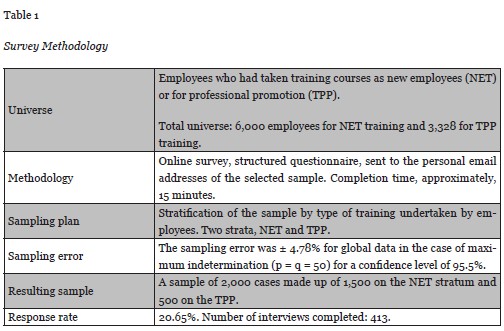
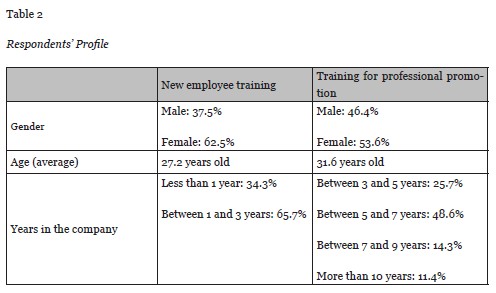
The perceptions of employees regarding face-to-face and virtual training have been obtained through the association of these training methods to a series of attributes related to the contents of the training courses (i.e., to their adaptability and applicability to the trainee’s professional activity and the ease of communication with the course instructor/tutor). These aspects have been extracted from the literature regarding e-learning referenced in the theoretical framework in this work. Table 3 shows the percentage of employees that associated which aspect with which type of training (virtual, face-to-face), to both types equally, or to neither of them.
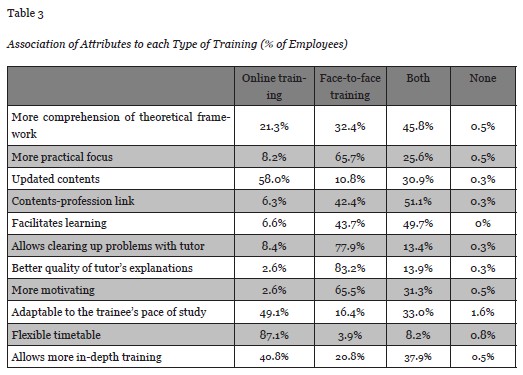
From these data we can highlight the main attributes linked to each of the methodologies. Thus, workers associate virtual training, in a higher percentage, with time flexibility (87.1%) and updated contents (58.0%). On the other hand, face-to-face training is more associated with perception of the quality of the tutor’s explanations (83.2%) or allows clearing up problems with the tutor (77.9%). However, the interviewed workers state that both virtual training and face-to-face training share a set of features. That is to say, a good link between contents and professional activity can be attained with both methodologies (51.1% of workers associate this aspect to both the virtual and the face-to-face training), or both allow more in-depth training (49.7%) and the understanding of the theoretical framework of training programmes (45.8%).
To take a more in-depth look at associations between the different characteristics of training and the two methods observed in this study, a simple correspondence analysis was carried out. Benzecri (1982) explains that this analysis endeavors to discover the structural dimensions that are latent in a set of data. This aims to analyse the relationship between two sets of variables, in this case training attributes/characteristics and training methodologies (online, face-to-face, both), as well as to go deeper into the perceptions of the CaixaBank workers with regard to face-to-face and virtual training. This is done by evaluating each of the different training methods’ images and positioning by means of a series of characteristics. Moreover, this analysis also allows the simultaneous representation of both sets of variables within the same two, three, or more dimensional spaces, which makes interpretation of the results easier. To do this analysis, we have taken into consideration the association of attributes with virtual training, with face-to-face training, and with both. We omitted information regarding the association of attributes with none of the two methodologies. The starting point of the correspondence analysis is a matrix of non-negative values, such as the cross-tabulation matrix (Table 4). The values represent the number of times each type of training is rated as being characterized by that attribute. Thus, higher frequencies indicate a stronger association between that training and the attribute in question.
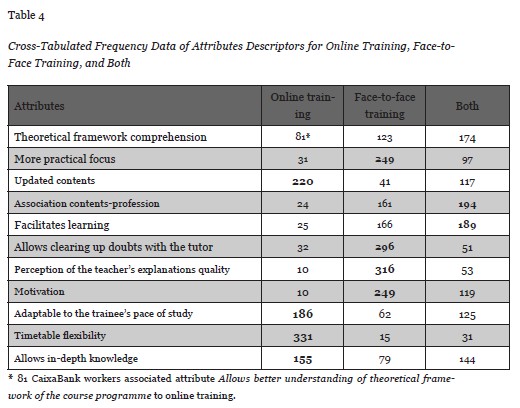
Table 5 shows the eigenvalues and the cumulative and explained percentages of variation for each dimension, corresponding to the two factorial dimensions taken from the analysis of correspondences.
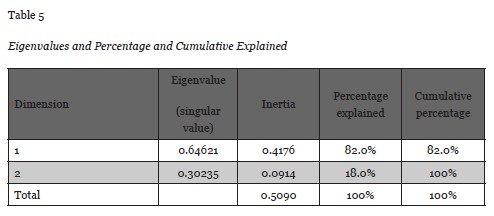
The symmetric relationship between factorial axes makes it impossible to take out more than K factorial axes, being K = min (I, J) – 1, where I is the number of attributes and J the number of training methodologies analysed (Hair et al., 2010). Thus, in this case, the maximum number of factors to be taken out is 2 (2 = min (11, 3) – 1). It can be seen that the first factor or dimension explains the overall data to a great extent, 82%, whereas the second dimension explains the remaining data, 18%.
Table 6 shows the coordinates of the items analysed and the types of training and their contributions to training on the two factorial dimensions. We can see that the attribute flexible timetable has much weight in the first dimension, along with virtual training methodology. As regards the second dimension, there is no primary contributor; however, the type of training does have an influence when it comes to explaining it, particularly the two types of training methodology, face-to-face and virtual.
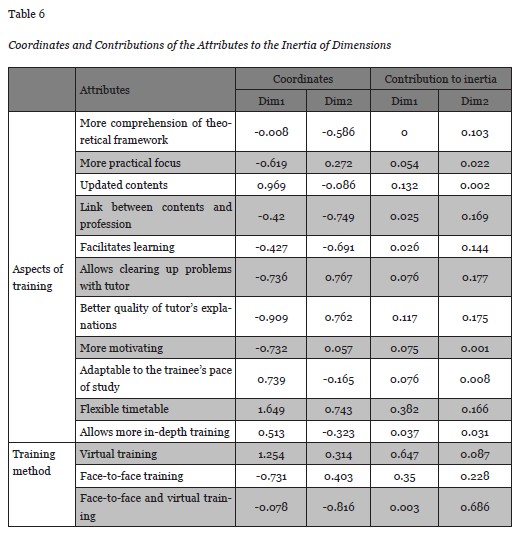
The data obtained highlights the importance of one of the analysed attributes, flexible timetable, in the contribution on the horizontal axis. This attribute would be positioned close to online training and far from the rest of the attributes on the positioning map. With the aim of determining if the elimination of this attribute would give rise to a clearer interpretation of the relationships between the attributes and the types of training, the analysis was repeated excluding this attribute. The resulting perceptual map (Figure 1) shows that the attributes that in the previous analysis did not appear to be clearly associated to either training method are “captured” by virtual training, giving it characteristics related to flexibility (adaptable to the trainee’s pace of study, more in-depth learning, and updated contents).
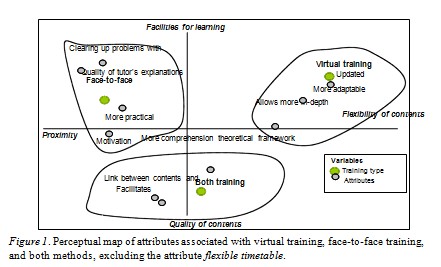
The map’s abscissa axis places at one extreme the characteristics related to proximity in the learning process, such as the possibility to clear up problems with a tutor, perception of the quality of the tutor’s explanations, more practical focus, and more motivating. At the axis’ other extreme the attributes related to flexibility of contents appear: updated contents, more adaptable to the trainee’s pace of learning, and allows more in-depth training. In this way, the face-to-face method is positioned close to the proximity attributes, and virtual training is positioned close to flexibility attributes. The ordinate axis places at the positive extreme aspects related to learning facilities and at the negative those related to quality of the contents. The aspects linked to the quality of content, such as learning facilities, link between contents and profession, and comprehension of the theoretical framework, are shared by both methods.
A 10-point scale (ranging from 0, strongly disagree, to 10, strongly agree) was used to measure questions about employees’ attitudes towards the training received. The perception of CaixaBank workers concerning the training received was, in general, very positive. Therefore, the level of agreement shown with the positive aspects evaluated is notable, while the most negative associations were not shared by the majority of employees. It is remarkable that 92.5% of employees were quite or completely in agreement that training offers an opportunity; 96.3% of respondents perceived training as a way to progress professionally; 92.7% considered it a way to keep their job; and 83.6% thought that training links them to the company.
Likewise, employees who have been at the company for less than two years had an appreciably more positive opinion of training than more veteran employees (a group which includes those who trained as TPP). With respect to the consideration of training as a cause of stress, in the case of the TPP trainees, 25.7% of them were quite or completely in agreement with this statement. By contrast, only 10.3% of NET trainees agreed with this opinion. The perception of training as a factor linking an employee to the institution was also markedly different depending on the kind of training undertaken: almost 87% of NET trainees completely agreed with the existence of this link, as opposed to 77% of employees who took part in TPP training. Finally, there are some motivational aspects where there are no statistically significant differences depending on the group that received the training (among these aspects, we can find I enjoy being up-to-date with everything related to my work, I feel the institution obliges me to do training, I think that training is part of my job, or The use of ICT is an added value for professional enrichment). Table 7 shows the percentage of workers who strongly and quite agree with each one of these motivations, according to the training undertaken by the employees (new-employee training or training for professional promotion).
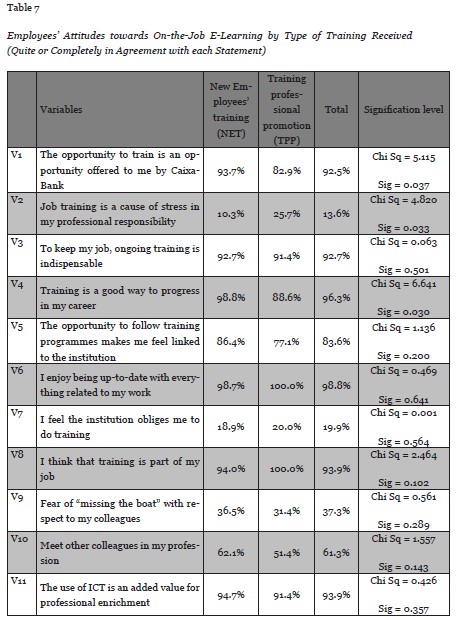
In order to confirm the existence of interdependent relationships between the variables that measure employee motivations for training, a factor analysis was carried out. We employed this multivariate technique from an exploratory perspective to identify a structure among the set of items analysed. Standard methods of performing factor analysis (i.e., those based on a matrix of Pearson’s correlations) assume that the variables are continuous and follow a multivariate normal distribution (Hair et al., 2010). In our research, the variables were measured on a 0 to 10 scale, so we took this ordinal metric into account and examined the dimensionality of the scale using factor analysis based on a matrix of polychoric correlations2, following the recommendations made by Panter et al. (1997).
To justify the application of factor analysis the Barlett test of sphericity and the Kaiser-Meyer-Olkin test were applied. KMO measure of sampling adequacy was good (> 0.80); and the Bartlett test of sphericity was statistically significant (p < 0.05). Table 8 shows the results of these tests.
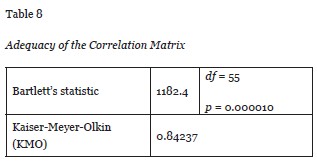
The analysis used principal components to extract the maximum variance from the items. According to the results, the number of factors suggested based on the polychoric correlation matrix is three when mean of random eigenvalues is considered. Table 9 contains the information regarding the 11 possible factors and their relative explanatory power as expressed by their eigenvalues.
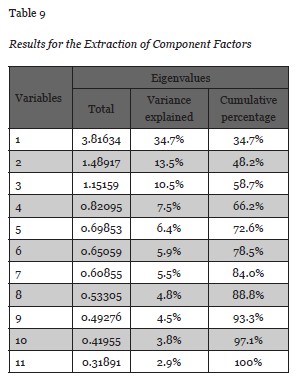
Finally, to minimize the number of items that have high loadings on any given factor, and in order to determine the interpretation of factors, a Varimax rotation was applied. Table 10 shows the Varimax-rotated component analysis factor matrix, where each variable’s correlation coefficient with each of the main components are found. Interpretation of the rotated component matrix allows us to identify and interpret three main factors, obtained from grouping the initial 11 variables.
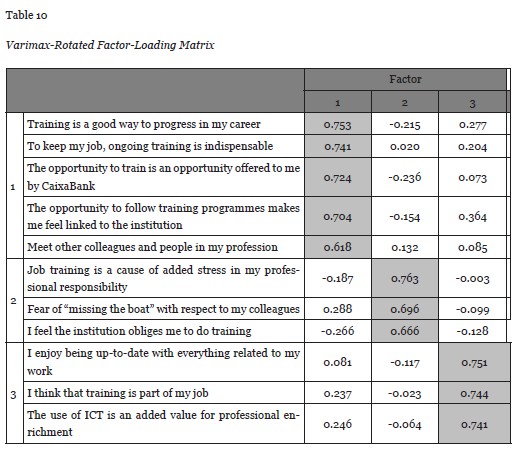
The analysis of factorial loadings allows the factors to be interpreted. Each factor is named based on the variables with significant loadings.
Factor 1. More affective and social motivations (34.7% of variance). This first factor has a more identifiable interpretation. On the one hand, it relates training to an affective link with the company and, on the other, it includes the only relational motivation for training (training for meeting other colleagues). This feeling of belonging to a group or an institution is complemented by the perception that training is, clearly, an opportunity offered by the company and a good way to progress in their careers.
Factor 2. Motivations that demonstrate poor adaptability or fear of the new training requirements (13.5% of variance). The motivations loaded on this second factor transfer training responsibility and initiative to the company (the employees do not have personal interest in their training) or imply that training is motivated by fear of being left in a detrimental position at work. In any case, this factor includes the perception that training is a focus of tension and not personal enrichment.
Factor 3. Motivations linked to the knowledge society (10.5% of variance). This third factor includes motivations concerning ongoing training that correspond to current training requirements, the need for lifelong training, and identifies training and profession as a unity and not as two separate stages. The use of ICT is already considered as an added value of training. Similarly, the variables loaded on this third factor clearly describe the reality of the current labour market: the constant need to learn and unlearn.
With the aim of validating the results obtained to the factor analysis, the sample was randomly divided into two parts and the analysis was applied to each of them. The resulting rotated component matrices showed that structures were equivalent, so we can conclude that the results are strong enough for their stability.
Throughout this case study we have attempted to explore workers’ attitudes and perceptions of on-the-job e-learning. The benefits of the distance methodology are clearly identifiable from the company’s point of view: as a flexible and efficient methodology to develop skills and employee expertise. From the employees’ standpoint, the advantages of virtual training are not so clear. The positioning map obtained from the association made by workers of different attributes to the two types of learning methodologies showed three main groupings, each corresponding with one type of training or both. Thus, the grouping of attributes related to face-to-face training are more motivating, clearing up problems with tutor, more practical focus, quality of the tutor’s explanations. Attributes related to online training consist of more updated content, more adaptable to the rhythm of the participant, and allows more in-depth training. The last set of attributes contained the characteristics that workers associated to both methods: facilitates learning, link between content and profession, and more comprehension of theoretical framework. Based on these results, we conclude that most of the benefits of virtual training in the workplace raised by Nisar (2002), Carnoy (2004), Wang, et al. (2006), or Hodges (2009) are perceived by workers of the financial institution.
By analysing the attitudes of employees regarding on-the-job training and their motivations for actively following the training courses, we can also conclude that there are three main groups of attitudes: those more affective and social motivations, those which reveal poor adaptability or fear of the new training requirements, and, finally, those linked to the knowledge society. These results highlight the need to break with the reluctance expressed by some of the workers from the fact that training is essential in the business world. To do this, we consider that the use of e-learning facilitates the development of training activities in the company, reducing training costs and achieving more flexible learning processes. As a final conclusion, employees must have an open attitude towards online training in order to achieve higher levels of efficiency in an on-the-job distance learning environment. On-the-job e-learning is most beneficial in situations where there is a great similarity between approaches to learning and to working, where a career in the intensive use of ICT is developed, and where up-to-date learning content is required.
Ashmalla, M., Mohamed, A.A., & Globashy, M.E. (2001). E-training: A future substitute for C-training? Global Competitiveness, 9.
Bachman, K. (2000). Corporate e-learning: Exploring a new frontier. Retrieved from http://www.spectrainteractive.com/pdfs/CorporateELearingHamrecht.pdf
Baldwin-Evans, K. (2004). Employees and e-learning: what do the end-users think? Industrial and Commercial Training, 36(7), 269-274.
Batalla, J.M., Martínez, M.J., & Vilaseca, J. (2010). La decisión empresarial de invertir en la mejora de la formación de los trabajadores: factores determinantes para el tejido empresarial catalán. Regional and Sectoral Economics Studies, 10, 93-116.
Bates, A.W. (2008). E-Learning and distance education resources. Retrieved from http://www.tonybates.ca/2008/07/07/what-is-e-learning/
Benzecri, J.P., & Benzecri, F. (1982). Practique de l’analyse des données. Paris: Dunod.
Bonk, C.J. (2002). Online training in an online world. Bloomington, Indiana: CourseShare.com.
Bresnahan, T.F., Brynjolfsson, E., & Hitt, L.M. (2002). Information technology, workplace organization, and the demand for skilled labor: Firm-level evidence. MIT Sloan School Working Paper, 154.
Brewer, E.W., Doo, H.L., & Cross, M.E. (2008). Job satisfaction and employee perception of the learning environment in the health care management industry. Journal of Leadership Studies, 1(4), 37-50.
CaixaBank. (2010). La Caixa Group annual report, 2010. Retrieved from http://press.lacaixa.es/reports/la-caixa-group-annual-report/__669-670__.html
Carnoy, M. (2004). ICT in education: Possibilities and challenges. Inaugural Lecture of the academic year 2004-2005 at the UOC. Retrieved from http://www.uoc.edu/inaugural04/eng/index.html
Carnoy, M. (2001). El trabajo flexible en la era de la información. Madrid: Alianza Editorial
Castells, M. (2003). La era de la información: Economía, sociedad y cultura, vol. 1 La sociedad en red. Madrid: Alianza Editorial.
Childs, S., Blenkinsopp, E., Hall, A., & Walton, G. (2005). Effective e-learning for health professionals and students – barriers and their solutions. Health Information and Libraries Journal, 22(2), 20-32.
Clarke, A., Lewis, D., Cole, I., & Ringrose, L. (2005). A strategic approach to developing e-learning capability for healthcare. Health Information and Libraries Journal, 22(2), 33-41.
Coetzer, A., & Perry, M. (2008). Factors influencing employee learning in small businesses. Education + Training, 50(8), 648-660.
Daneshgar, F., Van Toorn, C., & Edwin Chan, E. (2008). E-Learning in workplaces. Proceedings of the 6th International Conference on Information and Communications Technology (ICICT), IEEE Catalog Number CFP08618-PRT, Cairo, Egypt, 65-70.
Doo, H.L., & Hyunjoong, K. (2003). Motivation and learner characteristics affecting online learning and learning application. Journal of Educational Technology Systems, 31(4), 423-439.
Fan, C.S., & Wei, X. (2010). Training and worker effort: A signalling perspective. The Canadian Journal of Economics, 43(2), 604-621.
Grollman, W.K., & Cannon, D. (2003). E-Learning: A better chalkboard. Financial Executive, 19(8), 45-47.
Hair, J.F., Black, W.C., Babin, B.J., & Anderson, R.E. (2010). Multivariate data analysis. A global perspective (7th ed). New Jersey: Pearson Prentice Hall.
Hodges, A. (2009). Corporate e-learning: How three healthcare companies implement and measure the effectiveness of e-learning (Doctoral dissertation). The University of Alabama. Retrieved from http://acumen.lib.ua.edu/content/u0015/0000001/0000180/u0015_0000001_0000180.pdf
Jauregui, K. (2002). El e-learning en una institución financiera. IESE Occasional Papers, 3(6). Retrieved from http://www.iese.edu/research/pdfs/OP-03-06.pdf
Lim, D.H., & Kim, H. (2003). Motivation and learner characteristics affecting online learning and learning application. Journal of Educational Technology Systems, 31(4), 423-439.
Lorenzo-Seva, U., & Ferrando, P. (2012). FACTOR: A computer program to fit the exploratoy factor analysis model. Rovira i Virgili University. Retrieved from http://psico.fcep.urv.es/utilitats/factor/
Nisar, T.M. (2002). Organisational determinants of e-learning. Industrial and Commercial Training, 34(7), 256-262.
OECD (2010). Learning for jobs. Paris: OECD.
Ong, C., Lai, J., & Wang, Y. (2004). Factors affecting engineers’ acceptance of asynchronous e-learning systems in high-tech companies. Information & Management, 41(6), 795-804.
Pantazis, C. (2002). Maximizing e-learning to train the 21st. century workforce. Public Personnel Management, 31(1), 21-26.
Panter, A. T., Swygert, K. A., Dahlstrom, W. G., & Tanaka, J. S. (1997). Factor analytic approaches to personality item-level data. Journal of Personality Assessment, 68(3), 561-589.
Pedret, R., Sagnier, L., & Camp, F. (2000). Herramientas para segmentar mercados y posicionar productos. Análisis de información cuantitativa en investigación comercial. Bilbao: Ediciones Deusto.
Peretti, K. (2008). IT training - On the job. Training Magazine. Retrieved from http://www.trainingmag.com/article/it-training%E2%80%94-job
Piccoli, G., Ahmad, R., & Ives, B. (2001). Web-based virtual learning environments: A research framework and a preliminary assessment of effectiveness in basic IT skills training. MIS Quarterly, 25(4), 401-426.
Pulley, M. (2005). Corporate training blends technology with face time. Sacramento Business Journal. Retrieved from http://sacramento.bizjournals.com/sacramento/stories/2005/07/04/focus2.html
Rabak, L., Cleveland-Innes, M. (2006). Acceptance and resistance to corporate e-learning: a case from the retail sector. Journal of Distance Esducation, 21(2), 115-134.
Rosenberg, M.J. (2001). E-Learning: Strategies for delivering knowledge in the digital age. McGraw-Hill.
Ruipérez, G. (2003). Educación virtual y e-learning. Madrid: Fundación AUNA.
Ruiz, G. R., Mintzer, M. J., & Leipzig, R. M. (2006). The impact of e-learning in medical education. Academic Medicine, 81(3), 207-212.
Sangrà, A., Vlachopoulos, D., & Cabrera, N. (2012). Building an inclusive definition of e-learning: An approach to the conceptual framework. The International Review of Research in Open and Distance Learning, 13(2), 145-159. Retrieved from http://www.irrodl.org/index.php/irrodl/article/view/1161
Shankar, V. (2007). E-learning in the corporate world. Retrieved from http://www.articlesbase.com/online-business-articles/elearning-in-the-corporate-world-133828.html
Taylor, R., & Osorio, J. (2005). Economías del e-learning en la enseñanza superior: estrategias de implantación. Revista de Universidad y Sociedad del Conocimiento, 2(1), 85-99. Retrieved from http://www.uoc.edu/rusc
Valdaliso, J. M., & López, S. (2000). Historia económica de la empresa. Barcelona: Editorial Crítica.
Vilaseca, J., & Torrent, J. (2003). Economia del coneixement. Cap a una economia global del coneixement. Barcelona: Fundació per a la Universitat Oberta de Catalunya.
Wang, G., Foucar-Szocki, D., & Griffin, O. (2006). HRD learning participation: An empirical study of e-learning completion. Paper presented at the Academy of Human Resource Development International Conference (AHRD),1255-1262.
Wilson, B.G. (1996). Constructivist learning environments: Case studies in instructional design. Englewoods Cliffs: Educational Technology Publications.
Wurtmann, B., & Galli-Debicella, A. (2008). E-learning time: Benefits, misconceptions and challenges. Training Magazine. Retrieved from http://www.trainingmag.com/article/e-learning-time-benefits-misconceptions-and-challenges
Zhang, D., & Nunamaker, J. (2003). Powering e-learning in the new millennium: An overview of e-learning and enabling technology. Information Systems Frontiers, 5(2), 207-218.
1 According to the report Learning for Jobs (OECD, 2010), there are multiple on-the-job training typologies, of a punctual nature or structure and of longer length, aimed at inexperienced trainees, or with the purpose of their career promotion. Different training practices are described and classified regarding length of time and their level of structuring. At the shorter end of the time spectrum there is “Job shadowing” and at the longer end there is “Apprenticeships”. Likewise, the typology aimed at students entering the labour market is called “Service learning”, at which end we can find “Employee training”. This work focuses on the workers included in the latter training typology, “Employee training”, directed at workers who hold a permanent or temporary contract, with well- structured contents and carried out entirely in the workplace.
2 Tetrachoric and polychoric correlations are based on the assumption that the response categories (dichotomous or ordinal scales, as Likert scale) are proxies for unobserved and normally distributed variables. Factor analysis of tetrachoric or polychoric correlation matrices are essentially factor analyses of the relations among latent response variables that are assumed to underlie the data and that are assumed to be continuous and normally distributed (Panter et al., 1997). For computing polychoric correlations, the Factor program by Lorenzo-Seva and Ferrando (2012) was used.